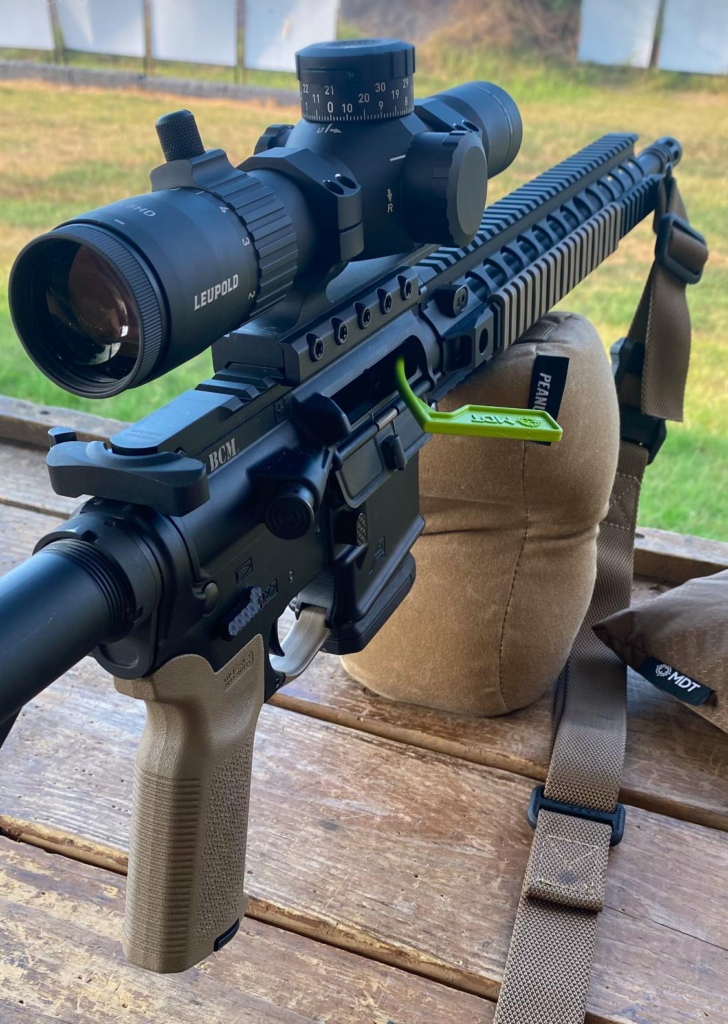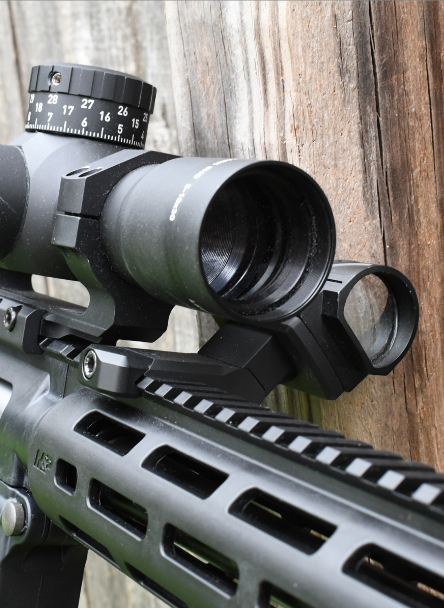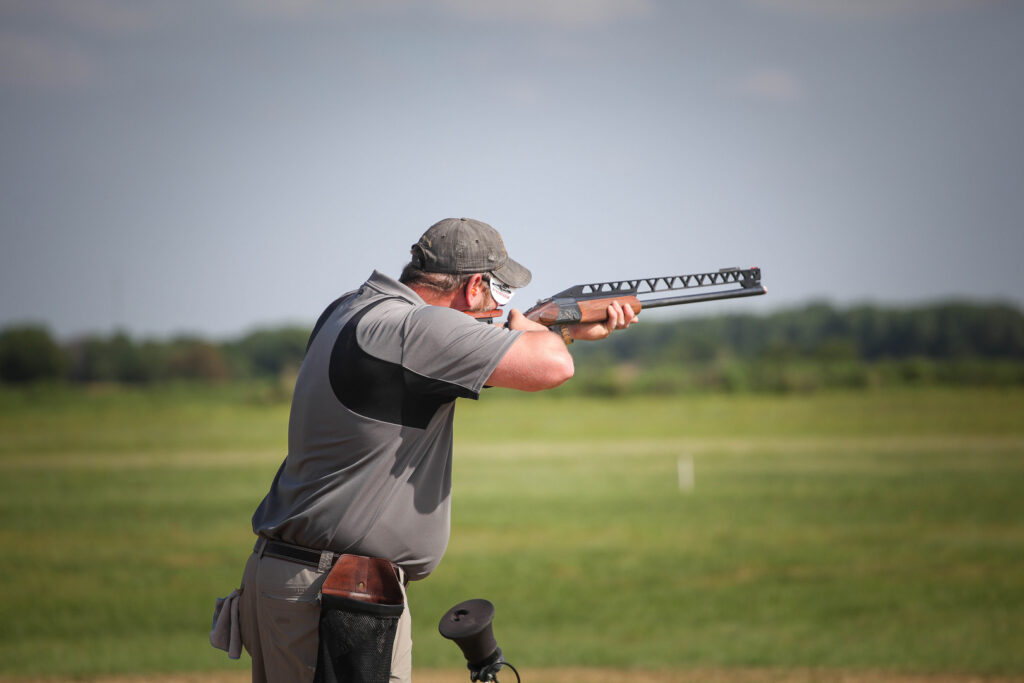Title Picture: Admittedly, mounting the Leupold Mark 5HD 2-10×30 riflescope on a heavy-barreled 6.5mm Creedmoor bolt-action rifle is weird, but sometimes you take what you can get for a nice photo, especially given the cool high desert background.
(Continued From Part 1)
Originally implemented as an improvement over the traditional mil-dot reticles that preceded it, the TMR replaces the old dots with evenly spaced hashmarks at 0.5 mil intervals. The TMR is best described as a “dialing reticle” since it lacks grids, dots, or extra reference points. To its credit, the centermost aiming point has negative space, which I find aids in precision aiming.
Advertisement — Continue Reading Below
With the DOPE for one’s rifle and cartridge, it’s certainly possible to hold-over using the 0.5 mil spaced hashmarks. I did this often in the Green Ops course, especially at more distant steel targets. In fairness, I recognize that it’s no different than holding-over with the majority of standard LPVO reticles at top-end magnification.
M5C3 / M1C3 Turrets + Setting Zero

Ultimately, the TMR in the Mark 5HD 2-10×30 is meant to be dialed, and its M5C3/M1C3 elevation turret is designed to excel at that. The turret is easy to zero and set, and its “zero-stop” feature works well and provides physical cues. The turret’s markings and numbers are also very easy to track visually while shooting in position, especially prone.
Advertisement — Continue Reading Below
The M5C3/M1C3s turrets also allow shooters to dial up to 0.5 mils down from their zero for added flexibility. The windage and side-focus/parallax turrets are similarly designed and also easy to precisely adjust.
For clarity, the “5” and the “1” are codes that denote MRAD (5) or MOA (1). The “3” refers to the fact that Mark 5HD’s elevation turret is capable of 3 full rotations of elevation adjustment.
Setting the zero is quite simple. Make the shots and adjust the windage or elevation turrets as needed. Then, undo two tiny Allen screws to remove the exposed turret’s cap and re-set it with regard to the new zero.
Advertisement — Continue Reading Below
The turret cap features a flat button that locks the turret into the fixed zero position. To dial, one must depress this button, and once the turret is turned all the way “up,” the button mechanically recedes.
Among other things, it can signal the shooter that their turret is maxed out. For example, when I had the Mark 5HD 2-10×30 mounted on my 16-inch BCM upper and zeroed for 55-grain 5.56mm ammo at 100 yards, the scope maxed out roughly three clicks shy of that full 3 turn / 30 mil limit. Not bad.
Reticle Drawbacks

Advertisement — Continue Reading Below
I wouldn’t be the first to point out that the biggest downside that currently affects the 2-10×30 Mark 5HDs is their lack of modern reticle options. Though classic and precise, the TMR reticle isn’t without its drawbacks. This reticle makes more sense for a stationary and prone-fired heavy bolt gun that you dial as opposed to that more modern and dynamic carbine meant for 0-800 meter shots, say, like any SPR or modern accurized gasser.
With basic dot-grids to facilitate holdovers and their considerably thicker outer stadia lines that are easier to see at low magnification, a reticle similar to either Nightforce’s FC-DMx (ATACR LPVO) or the Vortex EBR-9 (Razor Gen3 LPVO) would be a better fit on a scope like the 2-10×30 Mark 5HD. Because of this, on any “tactical” semi-auto carbine, I’d argue that an offset/piggyback reflex sight is “mandatory.” For closer distances, the first focal plane arrangement can present some challenges too.
First Focal Plane for CQB?
As I mention in more detail in my TMR write-up, the combo of the reticle being presented in a first focal plane format along with its thin, cross-hair style form leaves much to be desired when it comes to providing an easy-to-see and fast-shooting close-quarters reticle. Hence my bringing up the other LPVOs above. Even the Vortex I mentioned above gets its fair share of criticism when it’s set to 1x for the same reason. When I shot CQB drills at the Green Ops carbine class with the Mark5 HD 2-10×30, it wasn’t so much that I was limited to 2x minimum magnification that made CQB shots more challenging. Rather, it was the combination of the TMR being thin and dark, especially in a first focal plane format. Had we not been shooting in bright daylight, it could have been more difficult to see the reticle, hence my argument for an offset dot being mandatory for very close targets. Shooting with it on low power isn’t the end of the world, but it’s definitely not ideal.
Advertisement — Continue Reading Below
However, I keep hearing chatter that Leupold is working on launching additional models with different reticles in the future. I’m looking forward to seeing what they bring us. The scope itself, its glass, the construction–it’s all superb.
The Takeaway
As a first focal plane scope in itself, the Mark 5HD 2-10×30 is a fantastic optic. Overall, it measures a total of 11.2 inches while only weighing 24 ounces. As a member of the Mark 5HD family, this 2-10×30 riflescope is built around a proven formula of strength, durability, optical clarity, and precision while maintaining a fairly light weight.
Be it turret clicks or the way twisting the zoom ring feels, this scope’s controls do not feel cheap and flimsy, something no one wants to feel on any scope. The Mark 5HD 2-10×30’s feature set and the way the scope is built—in the United States of America, by the way—provides the shooter with an extremely comfortable eyebox on both the lowest and top-end magnification.
Advertisement — Continue Reading Below
According to the official details on Leupold’s website, the delta in difference between both extremes is only 0.10-inch. However, when shooting, it honestly feels imperceptible. Moreover, its eye-relief is in the same ballpark as high-end LPVOs.
Compared To an LPVO
Where the Leupold Mark 5HD 2-10×30 utterly (and predictably) dominates is shooting at top-end magnification. Since it’s not an LPVO, it’s not plagued by the shortcomings associated with LPVOs straining to shoot fully zoomed-in. The eye box hardly changes and I found I didn’t have to shift my face like I do with LPVOs to shoot fully zoomed-in.
I also had the benefit of both an exposed dialing turret and the side-focus knob to adjust parallax if I needed them. Once again, during the Green Ops class, it felt like I was basically cheating during the portion of the course where students were shooting at the furthest targets at full magnification. This scope takes after its DMR/SPR ancestors, after all.
Advertisement — Continue Reading Below
Accurate tactical semi-auto rifles aside, I can see this scope working well on a modern light-and-handy bolt-action hunting rifle meant for intermediate distances. In this way, it’s like your grandfather’s old 3-9×40, but better.
For more information, please visit Leupold.com.

Advertisement — Continue Reading Below















